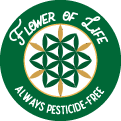
One day, I was shopping the produce section at my local grocer trying to decide between two different lettuces. I had the choice of a USDA organic option and a pesticide-free locally grown option. I wasn’t sure which option was cleaner but was influenced by the official organic seal. At the time, I was unaware that USDA organic certifications still allow for “organic” pesticide use. I was fooled into thinking organic meant pesticide-free. Now I know it doesn’t. What does this have to do with cannabis?
Organic is a misleading term.
In the cannabis industry, the term “organic” gets thrown around quite often which can be very misleading for consumers since there is no federal USDA regulation for cannabis. However, cannabis is regulated by each state with its own set of rules. In Oklahoma growers must pass testing for 12 pesticides1. In California that number is around 65 pesticides2 and in Canada it’s nearly 100 different compounds3. Unscrupulous growers can easily skirt around the regulated testing for 12 pesticides by using any number of pesticides which aren’t on the lab tests. To put that into perspective, there is approximately 900 different active pesticide ingredients on the market in the US.4
Pesticides haven’t been registered for use on cannabis.
The problem with pesticides used on cannabis is that they haven’t been tested for use on cannabis or registered for use on cannabis by the EPA. The EPA establishes pesticide safety tolerances for amounts used, timing and frequency of use. Without studying the specific use application of the pesticide, how can we be sure it’s safe?
Unfortunately we don’t know what happens when most pesticides are heated or combusted, i.e. vaporized or lit on fire and smoked, as cannabis flower often is. A quick example of this is Myclobutanil (active ingredient in Eagle 20), a once popular and sometimes still used pesticide turns into cyanide gas when combusted! There’s simply a lack of science based evidence on the safety of pesticide use on cannabis. For that reason, we’ve made a commitment not to use any pesticides or synthetic inputs, ever.
What is a pesticide?
I recently made mention of fungicide being a pesticide on Instagram and someone disputed the statement. Let’s define what a pesticide is so there isn’t any confusion. OMMA defines a pesticide as:
“”Pesticide” means (A) any substance or mixture of substances intended for preventing, destroying, repelling, or mitigating any pest, or (B) any substance or mixture of substances intended for use as a plant regulator, defoliant or desiccant.” 5
Fungicides, insecticides, plant growth regulators, herbicides and rodenticides all fall under the umbrella of pesticides.
Organic doesn’t mean pesticide-free.
Organic pesticides are still pesticides. The difference between organic and conventional pesticides is that organic pesticides are derived from nature and conventional pesticides are synthetically produced. Just because something is from nature, doesn’t necessarily make it safe, especially when its use application hasn’t been studied. Here’s a couple of examples of side effects of commonly used organic pesticides:
Pyretherins, a naturally derived insecticide from chrysanthemums has been shown to affect reproduction and possibly cause cancer. 6
Copper Sulfate, a fungicide commonly used in organic farming, has been known to cause “Vineyard Sprayers Lung”, where farm workers develop lung disease from inhalation exposure.7
Creating awareness about pesticide use on cannabis.
Lots of medical marijuana packaging claims to be organic and pesticide free. But are they truly? We, the cannabis community, must hold growers and processors accountable to these claims.
My concern is that many medical marijuana patients don’t realize the types of chemicals applied to the cannabis they’re purchasing. Further, many patients likely have some type of pre-existing condition or may be immune compromised. My hope is to make patients more aware of what they’re purchasing so they can make informed decisions.
I also fully believe in voting with your wallet. If we want to see change in this industry, we have to demand cleaner cannabis options. Do you value pesticide-free cannabis? Let us know in the comments below.
Sources:
1, 3, 5 Oklahoma State Department of Health, Medical Marijuana Control Program
2 Bureau of Cannabis Control text Of Regulations
4 Children’s Health and the Environment WHO Training Package for the Health Sector, July 2008
7 Pimentel JC, Marques F`Vineyard sprayer’s lung’: a new occupational disease Thorax 1969;24:678-688.
